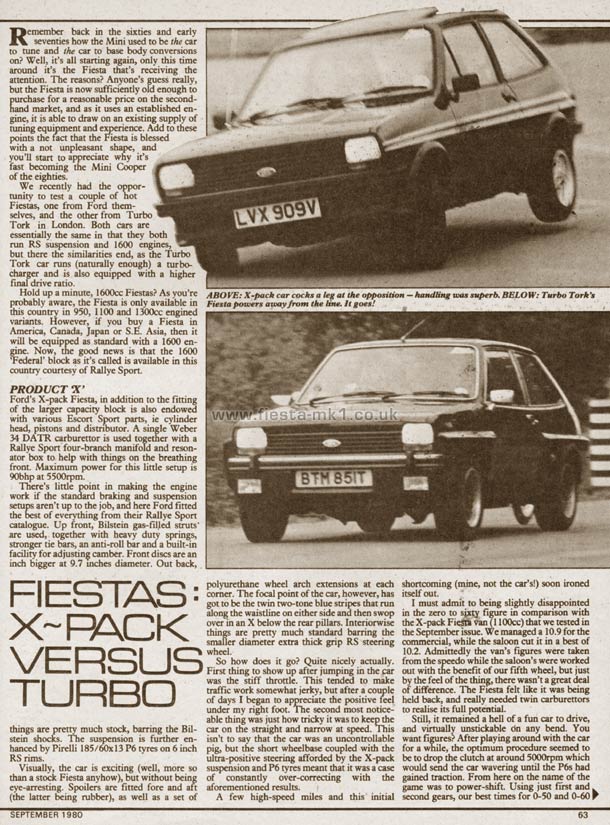Copy of Article Text Below
Black 'n' Blue
Remember back in the sixties and early seventies how the Mini used to be the car to tune and the car to base body conversions on? Well, it's all starting again, only this time around it's the Fiesta that's receiving the attention. The reasons? Anyone's guess really, but the Fiesta is now sufficiently old enough to purchase for a reasonable price on the secondhand market, and as it uses an established engine, it is able to draw on an existing supply of tuning equipment and experience. Add to these points the fact that the Fiesta is blessed with a not unpleasant shape, and you'll start to appreciate why it's fast becoming the Mini Cooper of the eighties.
We recently had the opportunity to test a couple of hot Fiestas, one from Ford themselves, and the other from Turbo Tork in London. Both cars are essentially the same in that they both run RS suspension and 1600 engines, but there the similarities end, as the Turbo Tork car runs (naturally enough) a turbo-charger and is also equipped with a higher final drive ratio.
Hold up a minute, 1600cc Fiestas? As you're probably aware, the Fiesta is only available in this country in 950, 1100 and 1300cc engined variants. However, if you buy a Fiesta in America, Canada, Japan or S.E. Asia, then it will be equipped as standard with a 1600 engine. Now, the good news is that the 1600 'Federal' block as it's called is available in this country courtesy of Rallye Sport.
PRODUCT 'X'
Ford's X-Pack Fiesta, in addition to the fining of the larger capacity block is also endowed with various Escort Sport parts, ie cylinder head, pistons and distributor. A single Weber 34 DATR carburettor is used together with a Rallye Sport four-branch manifold and resonator box to help with things on the breathing front. Maximum power for this little setup is 90bhp at 5500rpm.
There's little point in making the engine work if the standard braking and suspension setups aren't up to the job, and here Ford fitted the best of everything from their Rallye Sport catalogue. Up front, Bilstein gas-filled struts' are used, together with heavy duty springs, stronger tie bars, an anti-roll bar and a built-in facility for adjusting camber. Front discs are an inch bigger at 9.7 inches diameter. Out back, things are pretty much stock, barring the Bilstein shocks. The suspension is further enhanced by Pirelli 185/60x13 P6 tyres on 6 inch RS rims.
Visually, the car is exciting (well, more so than a stock Fiesta anyhow), but without being eye-arresting. Spoilers are fitted fore and aft (the latter being rubber), as well as a set of polyurethane wheel arch extensions at each corner. The focal point of the car, however, has got to be the twin two-tone blue stripes that run along the waistline on either side and then swop over in an X below the rear pillars. Interiorwise things are pretty much standard barring the smaller diameter extra thick grip RS steering wheel.
So how does it go? Quite nicely actually. First thing to show up after jumping in the car was the stiff throttle. This tended to make traffic work somewhat jerky, but after a couple of days I began to appreciate the positive feel under my right foot. The second most noticeable thing was just how tricky it was to keep the car on the straight and narrow at speed. This isn't to say that the car was an uncontrollable pig, but the short wheelbase coupled with the ultra-positive steering afforded by the X-Pack suspension and P6 tyres meant that it was a case of constantly over-correcting with the aforementioned results.
A few high-speed miles and this initial shortcoming (mine, not the car's!) soon ironed itself out.
I must admit to being slightly disappointed in the zero to sixty figure in comparison with the X-Pack Fiesta van (1100cc) that we tested in the September issue. We managed a 10.9 for the commercial, while the saloon cut it in a best of 10.2. Admittedly the van's figures were taken from the speedo while the saloon's were worked out with the benefit of our fifth wheel, but just by the feel of the thing, there wasn't a great deal of difference. The Fiesta felt like it was being held back, and really needed twin carburettors to realise its full potential.
Still, it remained a hell of a fun car to drive, and virtually unstickable tin any bend. You want figures? After playing around with the car for a while, the optimum procedure seemed to be to drop the clutch at around 5000rpm which would send the car wavering until the P6s had gained traction. From here on the name of the game was to power-shift. Using just first and. second gears, our best times for 0-50 and 0-60.....
Captions -
Middle - ABOVE: X-Pack car cocks a leg at the opposition - Handling was superb. BELOW: Turbo Tork's Fiesta powers away from the line. It goes!
|




